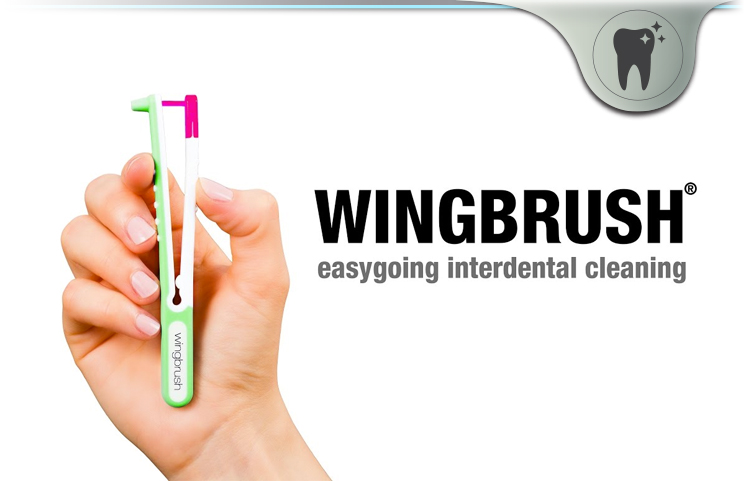Interdental cleaning, or the practice of cleaning the spaces between the teeth and the gums, is one of the most commonly overlooked aspects of oral hygiene.
Statistics collected by international toothpaste manufacturer Colgate show that up to 80% of people don’t floss or practice interdental cleaning techniques, which can lead to bad breath, tooth decay and gingivitis.
One of the primary reasons many people don’t practice this form of oral hygiene is the difficulty involved in cleaning the hard-to-reach interdental spaces with traditional solutions like floss.
The Wingbrush is a groundbreaking new interdental cleaning aid that has recently launched on the back of a wildly successful Kickstarter crowdfunding campaign.
Reaching over $300,000 USD in funding from tens of thousands of eager international backers, the Wingbrush promises to revolutionize the practice of interdental cleaning.
In this article, we’ll examine the design and construction of the Wingbrush and find out how it helps to streamline interdental cleaning practices, as well as take a look at some of the science the product is based on to help you decide whether it’s the right oral hygiene solution for you.

What Is Wingbrush?
Wingbrush is a simple oral hygiene tool that has been designed from the ground up to streamline the process of cleaning the harder-to-reach areas of the mouth, such as between the teeth, around crowns, under bridges, around implants, and for cleaning the components of brackets and braces.
Available in three separate sizes, the Wingbrush has captured attention from international media groups such as Glamour Magazine, Interesting Engineering and ZM online.
Designed to sit alongside the traditional toothbrush in the bathroom and used after normal brushing practices, the Wingbrush consists of an ergonomic handle that can be attached to a number of different cleaning heads for various interdental cleaning applications.
The core concept behind the Wingbrush is that a normal toothbrush is only able to reach 70% of the total dental surface inside the mouth, leaving almost a third prone to bacterial infection, decay, and cavities.
The unwieldy and difficult-to-use solutions that are commonly available on the market today such as floss or irrigators are similarly inefficient.
The Wingbrush has been created to provide health-conscious consumers with an easy-to-use and long lasting interdental cleaning solution that is as simple as the traditional toothbrush.

Wingbrush Design & Construction
The design of the Wingbrush consists of a forked, flexible handle that feeds a small, detachable brush through one side of the handle in a squeezing movement, pushing the small bristles of the interdental cleaning device between the gaps of the teeth.
Each Wingbrush ships with a number of variable size interdental cleaning brushes, which can be easily snapped on and off the Wingbrush handle.
The basic Wingbrush package comes with one of each of the three different tip sizes, which are designed for use between the teeth, around crowns, and for individuals with periodontitis.
The creators of the Wingbrush recommend cleaning the interdental spaces with their device once every 24 hours. Each individual brush lasts 2-3 days, with replacement tips available via the product website.
The handle of the Wingbrus is intended to last as long as a traditional toothbrush, offering a significant increased in cost-effectiveness over other disposable interdental cleaning devices.

Wingbrush Science
The Wingbrush was created in response to a meta-analysis of over 1000 different individual clinical dental studies, resulting in the development of the early prototypes of the revolutionary interdental device that is now available from the product website.
Although many people choose to overlook their interdental spaces, there is a significant body of evidence that demonstrates it can be hazardous to the oral health to ignore it.
A 2008 clinical dental trial conducted by the University for Applied Sciences in Amsterdam has conclusively proven that there is no scientifically-verifiable benefit to using floss to clean the interdental spaces[1].
Interdental cleaning devices, however, have been demonstrated in many trials to offer a number of distinct advantages. A 1998 trial conducted by the Academic Centre for Dentistry in Amsterdam proved that interdental devices are more effective than floss in cleaning the teeth[2].
Another study performed by the same Academic Center in 2008 concluded that interdental cleaning devices offer a wide range of health benefits, lowering the total levels of plaque in the mouth, minimizing the risk of causing gum bleeding, and improving total overall oral health[3].
Wingbrush Review Summary
Interdental cleaning is definitely a vastly under-practiced and critically important aspect of oral health that is frequently overlooked. The Wingbrush is a highly effective product that is backed up by clinical science and delivers a vastly improved oral health state.
If you’re looking for a way to improve your oral health and minimize the risk of developing tooth decay or bad breath, the Wingbrush is a cost-effective and easy-to-use solution that will keep your teeth healthy in the long term.
- https://www.ncbi.nlm.nih.gov/pubmed/19138178
- https://www.ncbi.nlm.nih.gov/pubmed/9706852
- https://www.ncbi.nlm.nih.gov/pubmed/19138177









